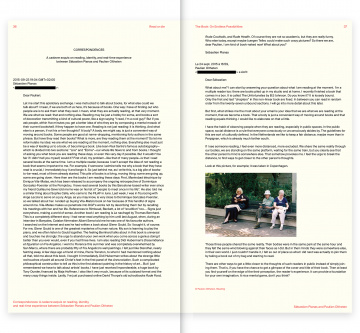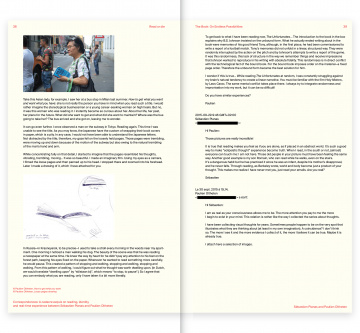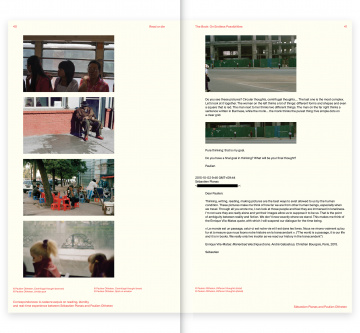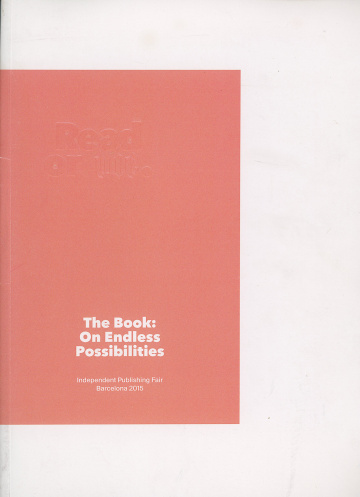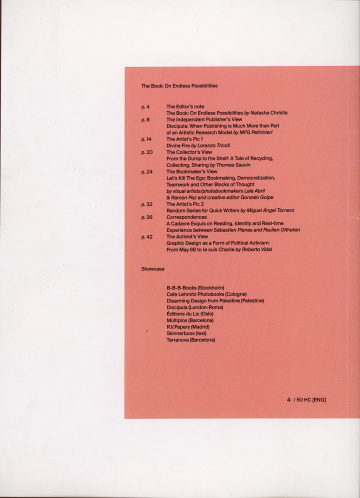Correspondence: A cadavre exquis on reading, identity, and real-time experience between Sèbastien Planas and Paulien Oltheten
> 2015-09-23 19:04 GMT+02:00
Sèbastien Planas
Dear Paulien:
Let me start this epistolary exchange. I was instructed to talk about books, for what else could we talk about? I mean, if we are both of us here, it’s because of books. One way I have of finding out who people are is to ask them what they read. I mean, what they are actually reading, at that very moment. We are what we read: that and nothing else. Reading may be just a hobby for some, and books a sort of decoration transmitting a kind of cultural power, like a sign saying “I read, I’m a cool guy!” But if you ask people, within five minutes you get a better idea of who they are by composing a mental mosaic of their current bookshelf, if they happen to have one. Reading is not just reading: it is thinking. And what else is a person, if not his or her thoughts? A body? A body, we might say, is just a convenient way of moving around books. Some people are good at name-dropping, mentioning forty authors in the same phrase. But have they read their books? What is more, are they reading them at the moment? So let me reformulate my idea: we are what we are reading at the moment, nothing else. Everything else must just be a way of leading us to a book, of becoming a book. Like Jean-Paul Sartre’s famous autobiography...which is divided into two sections: “Lire” and “.crire”―—our whole life flows to and from books. I thought of asking you what book you are reading these days, or even this very day if possible. But it wouldn’t be fair if I didn’t tell you myself, would it? First of all, my problem—―like that of many people―—is that I read several books at the same time. I am a multiple reader, because I can’t accept the idea of not reading a book that seems important to me. For example, if someone I admire tells me why a book that they have read is crucial, I immediately buy it and begin it. So just behind me, as I write this, is a big pile of booksto-be-read, most of them already started. This pile of books is a living, moving thing: some are going up, some are going down. Here then are the books I am reading these days: First, Marienbad électrique by Enrique Vila-Matas, wich has been released to accompany the ongoing retrospective of Dominique Gonzalez-Foerster at the Pompidou. I have read several books by this Barcelona-based writer ever since my friend Guillaume Seve told me he was on his list of “people to meet once in his life”. He also told me a similar thing about Sophie Calle, who came to the FILAF in June. Last week, I was in Tourcoing with Ange Leccia to serve on a jury. Ange, as you may know, is very close to Dominique Gonzalez-Foerster, so we talked about her. I ended up buying Vila-Mata’s book on her because of this handful of signs around me. Vila-Matas makes us penetrate into DGF’s works not by describing them but by recalling his meetings with her and her life. References to Rimbaud, Beckett, a lot of “erudition” too…. Signs just everywhere, making a world of sense. Another book I am reading is Le naufragé by Thomas Bernhard. This is a completely different story. I had never read anything by him until last August, when, during an interview in Banyoles, Catalan filmmaker Albert Serra told me he was one of his favourite authors. I searched on the Internet and saw he had written a book about Glenn Gould. So I bought it, of course. For me, Glenn Gould is one of the greatest mysteries of human nature. My son is learning to play the piano, and we often listen to Gould together. The feeling Bernhard talks about in this book is universal and touches me strongly: the urge to abandon your own work when you come across a genius doing it better than you ever would, even if you had three lives. I am also reading Didi Huberman’s Dissemblance et figuration on Fra Angelico. I went to Florence this summer and was completely overwhelmed by San Marco, where there are probably fifty of Fra Angelico’s wall paintings. I felt just like Stendhal, nearly fainting away. A few days ago a friend of mine, Pierre Torreton, to whom I had mentioned nothing about all that, told me about this book. I bought it immediately. Didi Huberman writes about the strange little red touches of paint all around Christ’s feet in the first panel of the Annunciation. Such a complicated philosophical construction to tell us this is the first abstract painting in the history of art... But I just remembered we have to talk about artists’ books. I have just received Imponderable, a huge book by Tony Oursler, financed by Maja Hoffman. I also like it very much, because of its outsized format and the many crazy things inside. Lastly, I’ve just purchased online David Thorpe’s old schoolbooks Rude Food, Rude Cocktails, and Rude Health. Of course they are not so academic, but they are really funny. Who else today, except maybe Juergen Teller, could make such crazy pictures? So there we are, dear Paulien, I am kind of book-naked now! What about you?
Sèbastien Planas
> Le 24 sept. 2015 . 16:59,
Paulien Oltheten
Dear Sèbastien:
What about me? I can start by answering your question about what I am reading at the moment. I’m a multiple reader too: there are books piled up in my studio and at home. I recently finished a book that comes in a box. It is called The Unfortunates by B.S Johnson. Do you know it? It is loosely bound. Only the first and last “chapters” in this non-linear book are fixed. In between you can read in random order from the twenty-seven unbound sections. I will go into more detail about this later.
But first, what strikes me the most about your email is your idea that we are what we are reading at the moment, that we become a book. That a body is just a convenient way of moving around books and that reading equals thinking. I would like to elaborate on that a little.
I have the habit of observing people when they are reading, especially in public spaces. In the public space, social distance is a rule that everyone consciously or unconsciously abides by. The guidelines for this are sort of culturally defined. In the Netherlands we like to keep a fair distance, maybe more than in Perpignan, which is already much farther south.
If I see someone reading, I feel even more distanced, more excluded. We share the same reality through our bodies, we are standing on the same platform, waiting for the same train, but you clearly see that the other person’s mind is somewhere else. That somehow provokes me. I feel the urge to break the distance, to find ways to get closer to the other person’s thoughts.
Look at this picture, for example; it was taken in Copenhagen.Those three people shared the same reality. Their bodies were in the same park at the same hour and they felt the same wind blowing against their faces as I did. But in their minds they were somewhere else, in their own world. I just couldn’t handle it, I felt so out of place so what I did next was actually to join them by taking a book out of my bag and starting to read.
There are other ways to get a little closer to the thoughts of such readers in public instead of simply joining them. That is, if you have the chance to get a glimpse of the cover and title of their book. Then at least you find yourself on the edge of the their perception, the reader’s experience. It can provide a foundation for your own imagination. A nice mental game, don’t you think?
Take this Asian lady, for example. I saw her at a bus stop in Milan last summer. How to get what you want and want what you have: she is not really the person you have in mind when you read such a title. I would rather imagine the stereotypical businessman or a young career-seeking woman on high heels. But no, it was this woman who was reading it. I instantly became so curious about her. About her life, her past, her plans for the future. What did she want to get and what did she want to maintain? Where was the bus going to take her? The bus arrived and she got on, leaving me to wonder.
It can go even further. I once observed a man on the subway in Tokyo. Reading again. This time I was unable to see the title. As you may know, the Japanese have the custom of wrapping their book covers in paper, which is a pity. In any case, I would not have been able to understand the Japanese letters.
Not distracted by the title, therefore, my gaze fell on the loosely held pages. Those pages were trembling, were moving up and down because of the motion of the subway but also owing to the natural trembling of the man’s hand and arm.While concentrating fully on that detail, I started to imagine that the pages resembled his thoughts, vibrating, trembling, moving... It was so beautiful. I made an imaginary film. Using my eyes as a camera, I filmed the loose pages and then panned up to his head. I stopped there and zoomed into his forehead. Later I made a drawing of it, which I have attached for you.
In Russia, in Krasnoyarsk, to be precise. I used to take a stroll every morning in the woods near my apartment. One morning I noticed a man walking his dog. The beauty of the scene was that he was reading a newspaper at the same time. He knew the way by heart for he didn’t pay any attention to his feet on the forest path, keeping his eyes fixed on the paper. Whenever he wanted to read something more carefully, he would pause. This created a pattern of stopping and walking, stopping and walking, stopping and walking. From this pattern of walking, I could figure out what he thought was worth dwelling upon. (In Dutch, we would translate “dwelling upon” by “stilstaan bij”, which means “to stop, to pause”.) So I agree that you can embody what you are reading, only I have taken it a bit more literally.
To get back to what I have been reading now, The Unfortunates… The introduction to the book in the box explains why B.S. Johnson insisted on the unbound form. What he actually ended writing about in the book were memories of his good friend Tony, although, in the first place, he had been commissioned to write a report of a football match. Tony’s memories did not unfold in a linear, structured way. They were randomly interrupted by the action on the pitch and by Johnson’s attempts to write a report of the game. It was this randomness, this lack of structure in the way we remember things and receive impressions that Johnson wanted to reproduce in his writing with absolute fidelity. This randomness is in direct conflict with the technological fact of the bound book. For the bound book imposes order on the material―—a fixed page order. Therefore the unbound form became the best solution for him.
I wonder if this is true... While reading The Unfortunates at random, I was constantly struggling against my brain’s natural tendency to create a linear narrative. You must be familiar with the film Holy Motors, by Leos Carax. The same mental conflict takes place there. I always try to integrate randomness and improvisation into my work, but it can be so difficult!
Do you have similar experiences?
Paulien
> 2015-09-29 9:46 GMT+02:00
Sèbastien Planas
Hi Paulien:
Those pictures are really incredible!
It is true that reading makes you feel as if you are alone, as if placed in an abstract world. It’s such a good way to make “solipsistic thought” experience become truth. When I read, in the south or not, (almost) everyone can touch me: I am not here. Those old people in your picture must have been feeling the same way. Another good example is my son Romain, who can read while he walks, even on the stairs. It’s a dangerous habit but he has practiced it since he was an infant, despite his mother’s disapproval, and he never falls. Through reading, as Berkeley wrote, world and body become just a product of your thought. This makes me realize I have never met you, just read your emails. Are you real?
Sèbastien
> Le 30 sept. 2015 . 19_14,
Paulien Oltheten
Hi Sèbastien:
I am as real as your consciousness allows me to be. The more attention you pay to me the more I begin to exist in your mind. This relation is rather like the way I collected the series about thoughts.
I have been collecting visual thoughts for years. Sometimes people happen to be on the very spot that illustrates what they are thinking about (at least in my own imagination). A coincidence? I don’t think so. The more I see it and the more evidence I collect of it, the more I believe it can be true. Maybe it is already true.
I attach here a selection of images.
Do you see these pictures? Circular thoughts, centrifugal thoughts.… The last one is the most complex. Let’s look at it together. The woman on the left thinks a lot of things: different forms and shapes and even a square that is red. The man next to her thinks two different things. The man on the far right thinks a sentence written in Burmese, while the monk… the monk thinks the purest thing: five simple dots on a clear grid. Pure thinking: that is my goal.
Do you have a final goal in thinking? What will be your final thought?
Paulien
> 2015-10-02 9:46 GMT+09:44
Sèbastien Planas
Dear Paulien:
Thinking, writing, reading, making pictures are the best ways to exist allowed to us by the human condition. These pictures make me think of how far we are from other human beings, especially when we travel. Through all you wrote me, I can look at those people and feel they are immersed in loneliness. I’m not sure they are really alone and yet their images allow us to suppose it to be so. That is the point of ambiguity between reality and fiction. We don’t know exactly where we stand. This makes me think of the Enrique Vila-Matas quote, with which I will suspend our dialogue for the time being.
Le monde est un passage, celui-ci est notre vie et il est dans les livres. Nous ne vivons vraiment qu’au fur et . mesure que nous lisons notre histoire en la transcendant .. (“The world is a passage, it is our life and it is in books. We really only live insofar as we read our history in the transcendent”)
Enrique Vila-Matas: Marienbad électrique (trans. Andr. Gabastou). Christian Bourgois, Paris, 2015.
Sèbastien
